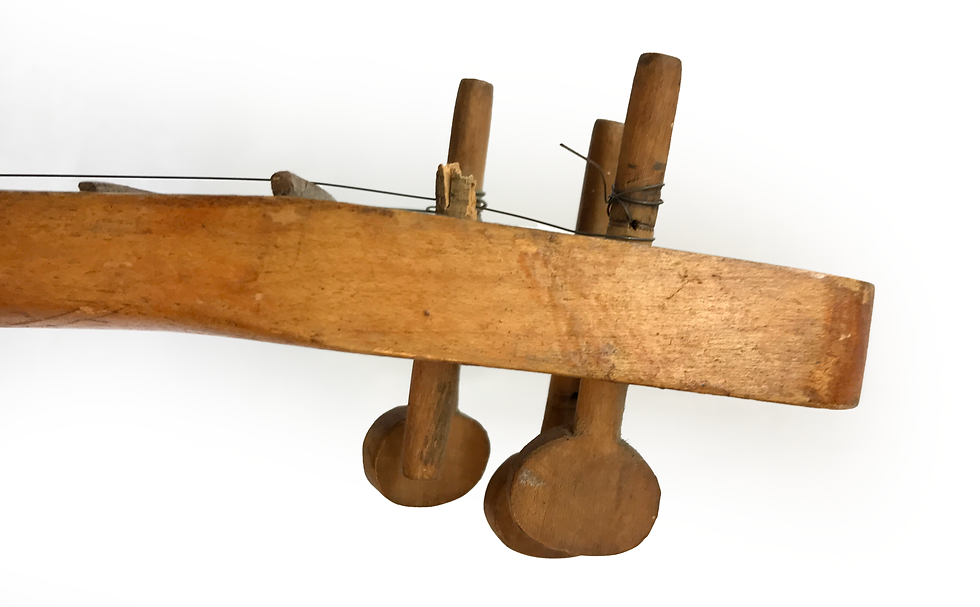Antique Trapezoid Guitar with Wood Frets & Elephant Inlay
- Shane Speal

- Jan 19, 2022
- 2 min read

This trapezoid shaped guitar was discovered in Maryland several years ago by an antique dealer, but not much else is known about it. I have a suspicion this was some sort of kit from the 1940's or 1950's because many parts seem too well made to be hand whittled. The body appears to be made of cedar or redwood and the top & back are attached with small nails and glue. There is no internal bracing except for a small strip of wood directly on the underside of the bridge area.

The neck attaches to the body with a heel that wraps around both top and bottom of the body. The glue has dried out after many years, allowing us to see the joint above.

The uniform look of the violin style tuning pegs is the first clue that this may be a kit. Each fits snugly into the tuner holes. One tuner is broken, as shown here.

The nut is made from a 3/32" wooden dowel rod. The headstock has a perfectly rounded crown, adding to my theory that this is a kit instrument.
If this was a kit, who was producing it? Did they have other instruments? Was this similar to the campfire ukulele kits of the 30's and 40's?

The frets are made of wood, possibly made from toothpicks. They were glued along the fretboard incorrectly up the fretboard. The octave hits at the 11th fret on this instrument and most other frets are positioned in the wrong places. If this was a kit, then the frets were not originally glued, leaving the task to the kit builder.

The sound hole is a 3" diameter circle. The bridge is reminiscent of ukulele style bridges and the slots hold ball-end guitar strings. It's held in place with two screws and glue. Only two strings remain.

The builder added an inlay of an elephant made from various shades of wood veneer. A slight chip at the top of the ear reveals that this is a thin veneer.

Here are the specs of the Trapezoid Guitar with Wooden Frets & Elephant Inlay
Scale length: 19"
Materials used:
Wood
Violin style tuning pegs
Slotted screws
Nails & glue
Wooden dowel nut
Wooden frets (toothpicks?)
Dimensions: 26 x 9 x 2" (60 x 23 x 5cm)
Body dimensions: 9" wide at butt end, 5.5" wide at the neck joint. 9.5" long and 2" deep.
Cigar Box Guitar Museum Catalog # ACB.2020.005
Currently in curation and slated to be shown at the Cigar Box Guitar Museum in New Alexandria PA at a future date.




If you look at the overall picture it appears the frets are spaced evenly with two spacings. A wider space up top and about half as wide lower towards the bridge. It looks like aesthetics had more to do with the location of the frets than tuning.
It's a neat looking instrument, I could see this being a kit build.
I have been toying with the idea of making my own tuning pegs for a while. And I especially like the inlay.
Definitely a nice find for your collection.
I'm quite sure that this is a kit. The mix of accuracy and inaccuracy is apparent in this example. Kits were popular when I was a kid. I used toothpicks for frets in my own instruments when I first started out in the 50s and 60s. It would be interesting to replicate this guitar using these woods; it would have an nice warm sound. The elephant inlay is a nice touch.
Interesting simple build. As you speculate some of the details seem to indicate it could have been a kit. It could be that the fret locations were determined by the builder by ear and he didn't have a good sense of pitch. If you listen to some of the early recordings it seems as if the instruments are slightly off key. Maybe that's a good reason to build fretless. I had a guitar player tell me once that the intonation on one of my early fretless builds was off and I suggested that he could always move his finger to compensate. Stay primal.